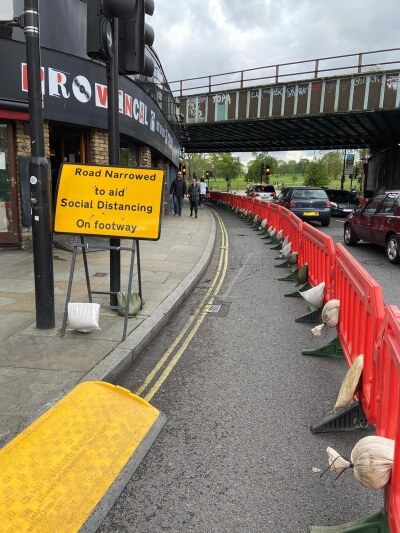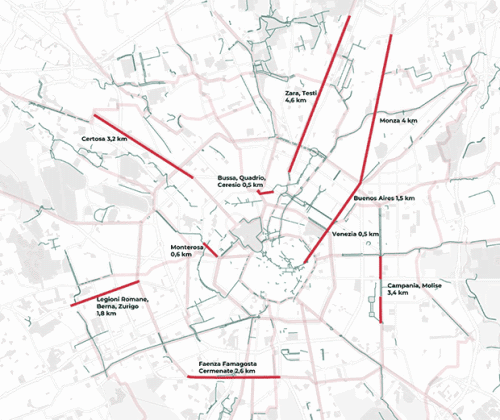"We don't want or need to go back to those fume-filled, congested and hostile roads of the past" - the message concluding a letter sent by campaigners to the leaders of Enfield Council concerned about what might happen once the coronavirus lockdown ends. They urge the leaders to to take steps to ensure that, as restrictions are gradually relaxed, high levels of car usage do not return, hindering social distancing and discouraging active travel modes - walking and cycling. Their suggestions include "pop-up" cycle lanes along corridors for key workers, widening of pinchpoints that present hazards when walking or cycling, and re-allocation of road space at places where queues outside shops make it impossible for pedestrians to maintain safe distances.

Lambeth Council has started reallocating space from motor vehicles to pedestrians - as shown here in Herne Hill
The letter sent today to council leader Nesil Caliskan and deputy leader Ian Barnes was signed by Viola Rondeboom and Clare Rogers from Better Streets for Enfield (BSfE) and the Enfield Cycling Campaign (ECC). Commenting on the current greatly reduced traffic levels, they say that, "While the cause of this drop is tragic, the benefits are undeniable: clean air, safe, quiet streets and a massive rise in people of all ages cycling both for exercise and essential journeys."
Calling for "immediate, decisive and strong leadership", the letter writers say that the crisis has shown that things can change very quickly when public safety is at risk. The coronavirus outbreak has been like a "crash diet for our streets", and "the question is, how many pounds do we want to gain again?"
The campaigners fear that, given the likelihood that people will be avoiding public transport, there could be a "catastrophic" rise in car use, leading to less walking and cycling because these are dependent on routes that feel safe and have lower traffic volumes: "Many key workers currently cycling to work or residents walking to the shops won’t continue when motor traffic levels return to pre-Covid levels or worse."
The letter points to active travel's crucial importance to public health. People become fitter and less obese, their lung health is improved, so they thare less vulnerable to Covid-19. Fewer cars also means less air pollution - and air pollution has been linked to worse outcomes for coronavirus patients.
Specific "asks" identified in the letter include removing pedestrian and cycling pinchpoints, such as the stretch of Aldermans Hill between the Triangle and the western side of the railway bridge. Creating more space where people are queuing, for example by suspending parking bays or closing service roads. Pop-up cycle lanes along key routes, such as Cockfosters to Wood Green via Southgate. And measures to prevent pollution levels in Brownlow Road returning to their previously normal but illegal levels - using a bus gate to stop cars using it as a through route.
What's happening elsewhere?
 Milan will be installing 35km of cycle lanes starting in May
Milan will be installing 35km of cycle lanes starting in May
Milan and Berlin are two European cities that are rolling out pop-up cycle lanes in connection with the coronavirus crisis, but they are being outdone by Paris, where the plan is to create no less than 650km of bike lanes in time for the easing of lockdown on 11th May.

Extra space for pedestrians in Barnes
Action of this kind is now beginning to occur in the UK - for instance, Leicester City Council has created a pop-up cycle lane along a key route used by staff at the Royal Infirmary while London has seen part of a road coned off in Barnes to make room for pedestrians - but there is confusion about the degree to which the government will allow local authorities to act quickly and whether councils are legally permitted to make changes of this sort without extensive prior consultation, as a result of which Hackney Council seem to have drawn back from the plans that I reported two weeks ago. However, David Harrison, vice-chair of London Living Streets, argues that by failing to implement such measures local authorities may not be performing their duty to secure the expeditious, convenient and safe movement of pedestrian traffic.
The capital's most ambitious scheme to date is now being implemented in Lambeth. An emergency transport strategy document produced by Lambeth Council has a four-phase plan intended to reflect the increasing relaxation of the lockdown. Measures include closing some roads to traffic, using point closures to create high quality routes into employment areas and town centres, implementing low-traffic neighbourhoods much sooner than previously envisaged, starting in May, widening pavements, extending bus lane hours and giving pedestrians more priority at crossings.
While Lambeth would bring in measures on a trial basis, their intention for phase 4 (when trip making will be "near normal" level) is to make re-allocation of road space permanent. A key element will be a borough-wide traffic order to cover a range of interventions and remove the need to make traffic orders for each one, made on the basis that it is designed to protect the public from danger. The document states that urgent measures such as narrowing or reducing traffic lanes to increase footway space do not require a traffic order and can be implemented under the highway permitting process.
Links
Lambeth Council: Transport response to Covid-19
Coronavirus-safe streets are needed now (London Living Streets)




